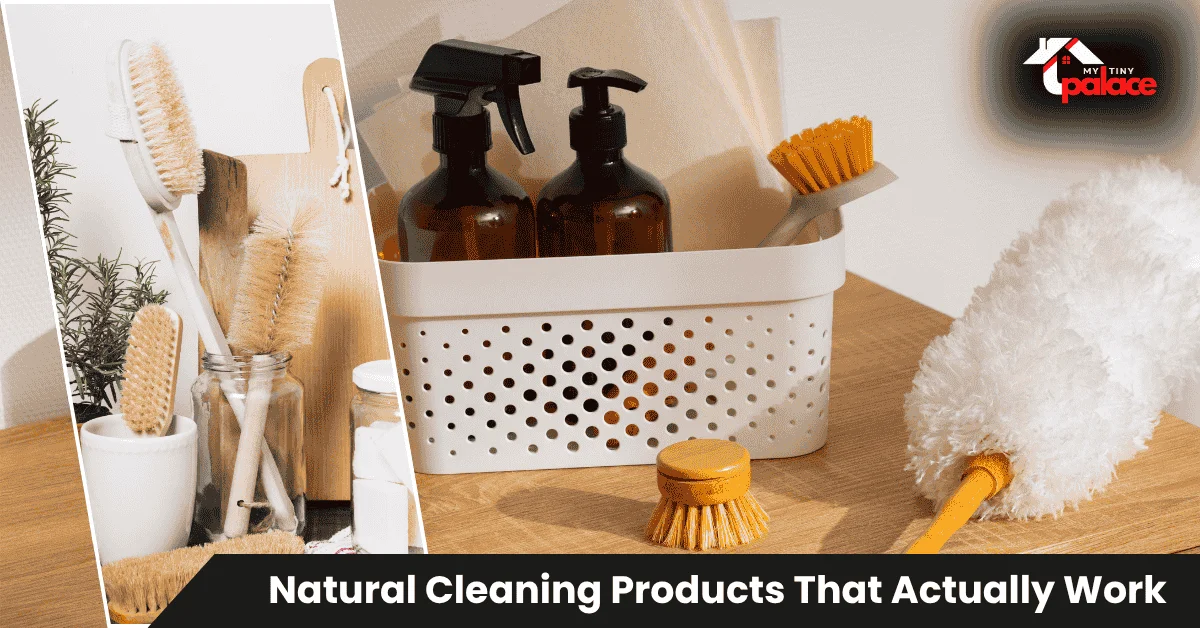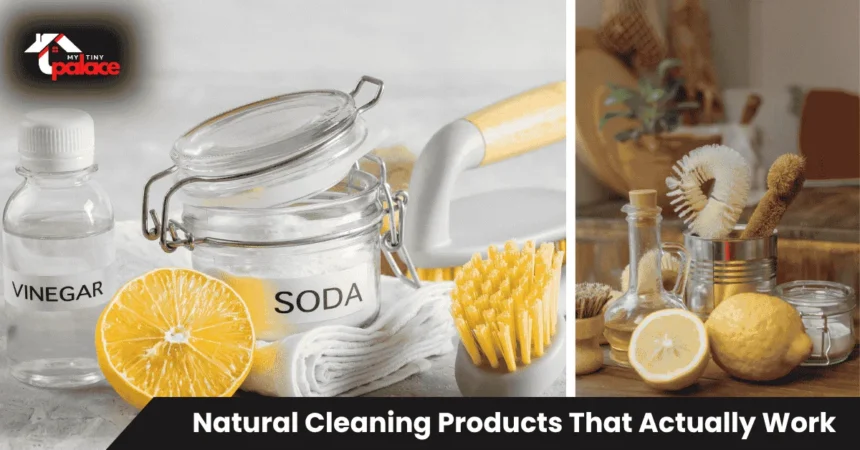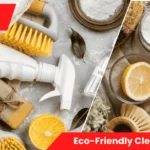More households are switching to natural cleaning products, but do they clean as well as traditional cleaners? The answer is yes — when you pick the right ones. Natural cleaners work beautifully for daily cleaning, and you can save money by mixing store-bought concentrated brands with two simple DIY recipes. This guide covers trusted picks, safety facts, room-specific solutions, and real costs so you can clean your home without harsh chemicals.
- Best Natural Cleaning Products
- What makes a cleaning product “natural”?
- Why it matters — health, home, and the planet
- How to choose the right natural cleaner for your home
- Room-by-room picks & core solutions
- DIY vs store-bought: when to mix and quick recipes
- Costs, time, tools — include a small table
- Pros & cons — who should consider natural cleaners
- Quick summary + CTA (what to do next)
Best Natural Cleaning Products
Natural cleaning products use plant-based ingredients instead of synthetic chemicals like bleach, ammonia, or phthalates. They clean dirt and grime effectively while being gentler on your skin, lungs, and the planet. Top approaches include refillable concentrated brands that cut plastic waste, budget-friendly DIY sprays made with vinegar or castile soap, and EPA-registered natural disinfectants for when you need germ control.
Here’s the tradeoff: natural cleaners remove dirt, grease, and most everyday mess. They don’t always kill viruses or bacteria the way hospital-grade disinfectants do. For regular cleaning, natural products work great. For high-risk situations like illness outbreaks, you might need stronger options.
What makes a cleaning product “natural”?
A truly natural cleaner relies on plant-based surfactants, essential oils, and biodegradable ingredients. It skips quaternary ammonium compounds (quats), synthetic fragrances, bleach, and phthalates. Look for products with clear ingredient lists, low volatile organic compounds (VOCs), and minimal synthetic dyes.
Certifications help you spot real natural cleaners. EWG Verified, Safer Choice, and Leaping Bunny labels mean third-party testing confirmed safety and transparency. Watch out for greenwashing — terms like “eco-friendly” or “green” without proof or ingredient disclosure.
If a bottle says “natural” but hides its formula or lists vague “fragrance,” skip it. Check resources like the Environmental Working Group’s cleaner database to verify safety ratings. A good natural cleaner tells you exactly what’s inside and how it breaks down after use.
Why it matters — health, home, and the planet
Natural cleaners improve indoor air quality by reducing harsh fumes that irritate your lungs and trigger allergies. They leave fewer chemical residues on counters, floors, and toys, which matters if you have kids crawling around or pets licking surfaces. Most natural formulas are gentler on your hands and safer for septic systems.
They’re also better for the environment. Biodegradable ingredients break down quickly in water systems, and refillable or concentrated options cut plastic waste. Many natural brands use recycled packaging and carbon-neutral shipping.
But natural cleaners have limits. Some pathogens — especially viruses like norovirus or bacteria like salmonella — need EPA-registered disinfectants to be fully eliminated. If someone in your household is sick or you’re dealing with raw meat spills, follow public health guidance and use a certified disinfectant when necessary. For everyday messes, natural cleaners handle the job safely.
How to choose the right natural cleaner for your home
Start by thinking about your needs: what rooms you clean most, what surfaces you have, and whether you need disinfecting power. Consider scent sensitivity too — some natural cleaners use strong essential oils that bother people with asthma or allergies. Factor in your budget and whether you’d rather buy ready-made products or mix your own.
Here’s a simple rule: if you clean daily and just need to wipe dirt and keep things fresh, DIY or mild natural sprays work perfectly. If you’re tackling grease, soap scum, or stains, buy a concentrated natural cleaner made for that job.
For example, a pet household needs enzyme cleaners to break down odors and stains without toxic residues. A rental with wood floors calls for pH-neutral natural formulas — vinegar is too acidic and can dull the finish over time. A busy kitchen with sticky grease benefits from citrus-based degreasers that cut through oil fast. Match the product to the task, and you’ll get great results without wasting money.
Room-by-room picks & core solutions

Kitchen: Grease builds up fast on stovetops and counters. Use a citrus enzyme degreaser or a castile soap spray. Brands with d-limonene (from citrus peels) work well here. For a DIY option, mix two tablespoons of castile soap with warm water in a spray bottle and add a few drops of lemon essential oil.
Bathroom: Soap scum and hard water stains need mild abrasives. Baking soda scrubs work beautifully on tubs and sinks without scratching. For mold on grout, try a hydrogen peroxide spray (three percent solution) or a natural brand with thymol, a plant-based antimicrobial. Avoid vinegar on natural stone like marble — it etches the surface.
Floors: Most hard floors do fine with a damp mop and a few drops of castile soap in warm water. For sealed wood, stick to pH-neutral natural cleaners to protect the finish. For tile, a vinegar-water mix (one part vinegar, three parts water) cuts through grime and dries streak-free.
Laundry: Plant-based laundry detergents with enzymes handle everyday stains well. Look for concentrated formulas in refill pouches to save plastic. Add half a cup of baking soda to the wash for extra deodorizing. Skip fabric softeners with synthetic fragrance — use wool dryer balls instead.
Glass and mirrors: Plain white vinegar diluted with water is the cheapest and most effective glass cleaner. Spray, wipe with a microfiber cloth, and you’re done. No streaks, no residue.
DIY vs store-bought: when to mix and quick recipes
DIY cleaners shine for daily tasks like wiping counters, cleaning glass, and freshening up surfaces. They’re cheap, simple, and you control every ingredient. Store-bought natural cleaners make sense for tougher jobs like stain removal, heavy grease, or when you want the convenience of a ready-made concentrated refill. If you need a certified disinfectant, buy one — DIY recipes can’t match EPA-registered germ-kill claims.
DIY multi-surface spray
Combine one cup of water, one cup of white vinegar, and ten drops of essential oil (lemon or tea tree) in a spray bottle. Shake gently. Spray on counters, sinks, and appliances, then wipe with a microfiber cloth. This works for daily cleaning but doesn’t disinfect. Never mix vinegar with bleach — it creates toxic chlorine gas.
Safe abrasive scrub (baking soda + castile soap)
Mix half a cup of baking soda with two tablespoons of liquid castile soap in a small jar. Stir until it forms a paste. Scoop a spoonful onto a damp sponge and scrub sinks, tubs, or stovetops. Rinse well with warm water. This scrub is gentle on most surfaces but test a hidden spot first.
Costs, time, tools — include a small table
Natural cleaning doesn’t have to drain your budget. DIY recipes cost pennies per batch. Store-bought concentrated natural brands cost more upfront but last longer than single-use bottles. Here’s a realistic monthly breakdown:
| Option | Monthly Cost | Time per Task | Tools Needed |
|---|---|---|---|
| DIY staples | $3–$8 | 5–10 min/week | Spray bottles, microfiber cloths, small jars |
| Brand refills (concentrated) | $15–$25 | 3–5 min/task | Reusable bottles, cloths, scrub brush |
| Single-use natural bottles | $20–$35 | 3–5 min/task | Spray bottles (disposable), cloths |
Over time, refills and DIY combos save the most money. You’ll also need a few good microfiber cloths, a sturdy scrub brush, and glass spray bottles if you go the DIY route.
Pros & cons — who should consider natural cleaners
Natural cleaners offer safer residues, especially for homes with kids, pets, or family members with asthma or allergies. They’re eco-friendly, often biodegradable, and gentler on surfaces like wood and stone. Many concentrated natural brands reduce plastic waste through refill systems.
The downsides: natural cleaners may not kill all pathogens, so they’re not ideal for medical-level disinfecting. Some formulas take a bit more scrubbing than heavy-duty chemical cleaners. Ready-made natural brands can cost more per ounce than conventional cleaners, though concentrates balance that out.
Who should use natural cleaners? Families prioritizing indoor air quality, renters who want safe and simple options, eco-conscious households, and anyone with sensitivities to synthetic fragrances or harsh fumes. If you need hospital-grade disinfection regularly, combine natural daily cleaners with EPA-registered disinfectants for high-risk tasks.
Quick summary + CTA (what to do next)
Start by picking one trusted concentrated natural brand for tough jobs and one DIY staple like vinegar or castile soap for daily cleaning. Test your setup this week on a small area — notice if surfaces feel clean without sticky residue or strong chemical smells. That’s your sign it’s working.














